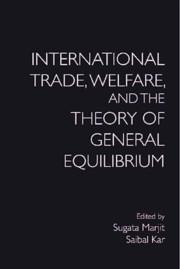Book contents
- Frontmatter
- Contents
- List of Figures and Tables
- Introduction
- 1 Thoughts and Remarks after 50 Years of Simple General Equilibrium Models
- 2 Adjustment Costs and Trade Liberalization
- 3 Farsightedly Stable FTA Structures: The Roles of Preexisting Tariff Rates
- 4 Skilled–Unskilled Wage Inequality and Dynamic Skill Accumulation: A Theoretical Analysis
- 5 FDI in Education vs FDI in Commodity Production: A Theoretical Model
- 6 Skilled Migration and Foreign Aid in a General Equilibrium Model of Monopolistic Competition
- 7 Trade, Factor Flows, and Product Variety in a Small Open Economy
- 8 Product Differentiation, Quality of Innovation, and Capital Mobility: A General Equilibrium Analysis
- 9 Cross-Border Mergers and International Trade: A Vertical GOLE Model
- 10 International Trade and Production Organization: A Review of Contemporary Literature
- 11 Negative Production Externalities, Labor Market Imperfection, and Production Tax Policy in a Developing Economy
- 12 Tax-Financed Public Transfers: A Mechanism for Double Taxation
- Contributors
- Index
3 - Farsightedly Stable FTA Structures: The Roles of Preexisting Tariff Rates
Published online by Cambridge University Press: 01 November 2018
- Frontmatter
- Contents
- List of Figures and Tables
- Introduction
- 1 Thoughts and Remarks after 50 Years of Simple General Equilibrium Models
- 2 Adjustment Costs and Trade Liberalization
- 3 Farsightedly Stable FTA Structures: The Roles of Preexisting Tariff Rates
- 4 Skilled–Unskilled Wage Inequality and Dynamic Skill Accumulation: A Theoretical Analysis
- 5 FDI in Education vs FDI in Commodity Production: A Theoretical Model
- 6 Skilled Migration and Foreign Aid in a General Equilibrium Model of Monopolistic Competition
- 7 Trade, Factor Flows, and Product Variety in a Small Open Economy
- 8 Product Differentiation, Quality of Innovation, and Capital Mobility: A General Equilibrium Analysis
- 9 Cross-Border Mergers and International Trade: A Vertical GOLE Model
- 10 International Trade and Production Organization: A Review of Contemporary Literature
- 11 Negative Production Externalities, Labor Market Imperfection, and Production Tax Policy in a Developing Economy
- 12 Tax-Financed Public Transfers: A Mechanism for Double Taxation
- Contributors
- Index
Summary
Introduction
Since the late 1980s, preferential (or regional) trade agreements such as customs unions (CUs) and free trade agreements (FTAs) have been growing rapidly in number and are becoming more prevalent in the international trade scene. Well-known examples of such preferential trade agreements include the European Union (EU), the North American Free Trade Agreement (NAFTA), the South American Common Markets (MERCOSUR), and the Association of South-East Asian Nations (ASEAN). Even Japan, which has for long been advocating for a multilateral approach to trade liberalization under the GATT/WTO regime, has already concluded a number of bilateral FTAs, which are sometimes referred to as the Economic Partnership Agreements (EPAs), with Singapore, Mexico, Malaysia, the Philippines, Chile, and other countries.
Bhagwati (1991, 1993) has argued that this trend of regionalism/bilateralism is harmful to the accomplishment of global free trade under the auspices of the GATT/WTO regime, which has been traditionally considered to be efficient and/or welfare enhancing from the point of view of the world as a whole. Further, he has raised questions as to whether preferential trading blocs (CUs and/or FTAs) reduce or increase the welfare of the world and whether the prevalence of bilateralism/ regionalism can eventually lead to a situation where the welfare of the world is maximized. In other words, he raises a question as to whether preferential trading blocs can be a ‘building block’ for or a ‘stumbling block’ against the achievement of global free trade. The former can be traced back to the question raised by Viner (1950) whether preferential trading blocs could be trade-creating or trade diverting. The latter is now known as the ‘dynamic time-path’ question.
To answer these questions raised by Bhagwati (1991, 1993), a considerable number of theoretical as well as empirical literature has emerged. Recent theoretical studies (on the ‘dynamic time-path’ question) can be split into the following two interesting approaches: one approach is based on the coalition/network formation games, and the other approach is based on some ‘dynamic’ games.
For example, Yi (1996, 2000), Das and Ghosh (2006), and Saggi and Yildiz (2010) have followed the line of coalition formation game approach. Yi (1996) has constructed a model with ex ante symmetric countries, in which countries intend to form CUs of certain sizes.
- Type
- Chapter
- Information
- Publisher: Cambridge University PressPrint publication year: 2018



